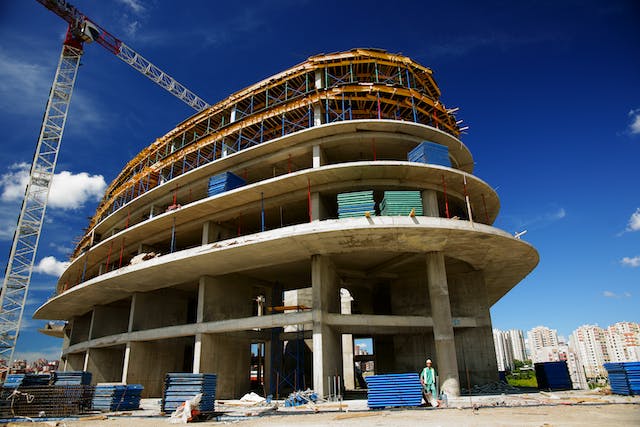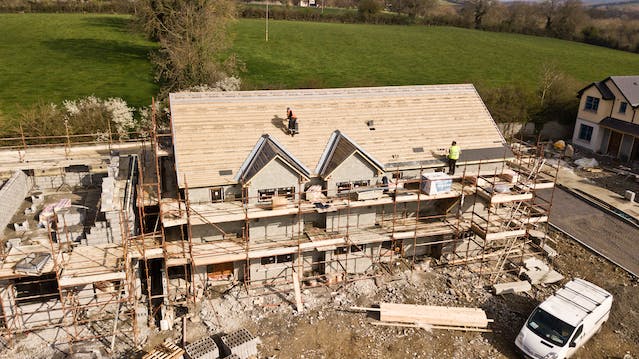In the quest for sustainability, the construction sector stands at a crossroads. Historically known for its substantial carbon footprint, the industry faces increasing pressure to reinvent its practices and reduce its impact on the planet.
With the UK’s ambitious targets to cut carbon emissions by 78% by 2035, construction managers are under the spotlight to pioneer change. They have a significant role to play in meeting these goals, and the time for action is now.
The construction industry is often seen as a heavyweight in the ring of carbon emissions, but innovative methods and smart technology are now leading the charge in the battle against CO2.
Let’s delve into six effective strategies construction managers can adopt to reduce their CO2 emissions.
1. Sustainable Building Materials: Building Blocks for a Cleaner Planet
The path to sustainability is paved with green building materials. Embracing these alternatives is akin to planting seeds for a future where construction doesn’t come at the expense of our environment. The traditional contents of concrete come with a heavy carbon baggage – from high energy production processes to transportation emissions.
On the flip side, sustainable material such as green concrete presents a double win: it requires less energy to produce and is often lighter, reducing emissions during transportation. By pushing the boundaries of innovation, construction managers can also investigate emerging materials like self-healing concrete or bio-bricks, which promise even greater environmental benefits and further cut down the carbon cost of construction projects.

2. Powering Sites with the Wind and Sun: Harnessing Nature’s Bounty
Incorporating renewable energy into construction operations doesn’t just cut CO2 emissions; it positions construction firms as leaders in the fight against climate change. The integration of solar panels not only provides clean energy but can be a statement of intent, showcasing a commitment to sustainability.
Wind turbines can complement this, capturing energy even when the sun sets.
Over time, the energy generated from these installations can provide a consistent, cost-effective power supply that also insulates companies from volatile fossil fuel markets. It’s about building resilience while building structures, ensuring that construction sites are not just consumers of energy but also producers of clean, green power.
3. Prefabrication: A Blueprint for Efficiency: Crafting Components, Conserving Carbon
Prefabrication and modular construction techniques are gaining momentum as pillars of modern, low-carbon construction methodologies. By assembling components in a controlled factory environment, construction managers can cut down on waste dramatically.
In the factory setting, precision is higher, material usage is optimized, and leftovers can be recycled internally, which is often not feasible on a traditional construction site. Moreover, with components arriving on-site ready to install, there is a significant reduction in on-site activity, which translates into fewer days of machinery running and less energy consumed.
This approach not only speeds up the construction process but also mitigates the environmental disturbances often associated with building sites, including noise pollution and land disruption. Furthermore, the reduction in the duration of the construction phase means a shorter time frame for emissions to occur, hence a leaner carbon footprint from start to finish.

4. Sensors: The Keystone of Smart Construction
Sensor technology offers a compelling narrative in the story of sustainable construction. These sensors, like the ones from Converge, are not just about monitoring; they’re about actively reducing the carbon footprint of construction activities.
The real-time data they provide on concrete strength can potentially trim days off construction schedules, as builders no longer need to wait for conservative estimate periods to ensure curing has occurred. This precision reduces the time heavy equipment is left running, thus slashing emissions.
Beyond this, Converge’s environmental monitoring capabilities allow construction managers to track and adapt to changing site conditions, minimizing the risks of overusing resources. The ripple effect of such data is vast: optimized equipment use leads to reduced fuel consumption, and efficient scheduling cuts down on the manpower and energy required, further driving down the site’s carbon emissions.
Implementing these smart sensors is a strategic investment that pays environmental dividends by harnessing the power of data for greener building sites.
5. Waste Not, Emit Less: A Circular Approach to Construction
Effective waste management and reduction strategies in construction are essential for both environmental stewardship and economic efficiency. Beyond standard recycling, managers can explore the adoption of circular economy principles, where materials are reused and repurposed to their maximum potential.
Implementing meticulous sorting processes for waste materials can ensure that a maximum number of resources are recovered, reducing the demand for new materials and the emissions associated with their production.
Advanced planning can also minimize cut-offs and unused materials, and ordering supplies in precise quantities based on accurate plans can reduce excess. Moreover, by choosing suppliers who take back packaging or unused materials, construction sites can further reduce their waste footprint.
It’s about creating a closed-loop system where every material has a planned second life, significantly decreasing the volume of waste that ends up in landfills and the associated greenhouse gas emissions from waste management.

6. Education: Laying the Groundwork for Eco-conscious Construction
Education is the cornerstone of any significant change, including the transition to low-carbon construction practices. It’s not enough to have a few advocates for sustainability; a site’s entire team should understand the why and how of green building practices.
This means regular training sessions, sharing best practices, and keeping the crew updated on new regulations and technologies. It also means encouraging innovation and feedback from the team – often, those on the ground have invaluable insights into how processes can be improved.
Closing Thoughts
Empowering staff with the skills and knowledge to operate new eco-friendly machinery, apply sustainable building techniques, and manage resources efficiently can transform the culture of a construction site. Engaging staff in sustainability goals and rewarding eco-friendly initiatives can further embed this mindset.
By investing in education, construction managers are building a workforce that’s not just skilled but also motivated to drive down emissions and champion a greener future for the construction industry.
Author Profile

- Blogger by Passion | Contributor to many Business Blogs in the United Kingdom | Fascinated to Write Blogs in Business & Startup Niches
Latest entries
 Health & BeautyJune 24, 2025Beyond the Pill Bottle: 4 Pharmaceutical Packaging Innovations Making Medicine Safer and Smarter
Health & BeautyJune 24, 2025Beyond the Pill Bottle: 4 Pharmaceutical Packaging Innovations Making Medicine Safer and Smarter Business AdviceJune 23, 20257 Smart Ways London Exporters Can Navigate Customs Paperwork
Business AdviceJune 23, 20257 Smart Ways London Exporters Can Navigate Customs Paperwork EntertainmentJune 13, 20258 Benefits New Casinos Offer Players Over More Established Ones
EntertainmentJune 13, 20258 Benefits New Casinos Offer Players Over More Established Ones BusinessMay 9, 2025The Data-Driven Future of Online Services in the UK
BusinessMay 9, 2025The Data-Driven Future of Online Services in the UK


